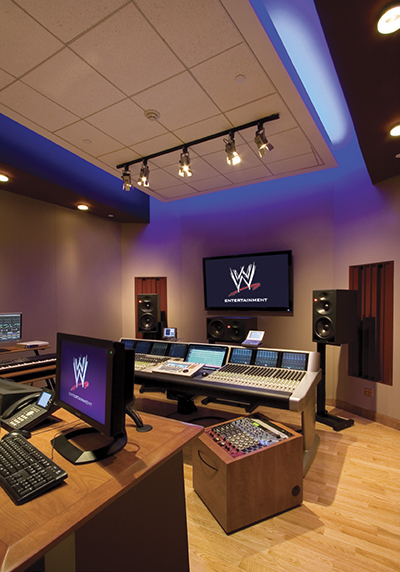A New Smackdown Sound for WWE
STAMFORD, CONN.—World Wrestling Entertainment completed a major upgrade and expansion to its technical operations center here recently that included HD ingest and edit rooms, QC and transmission, core router replacement and upgrade, and Audio Post 3, the newest 5.1 surround sound audio suite in the facility.
The 375-square-foot Audio Post 3 took over space previously occupied by a voiceover booth, machine room, and a small audio control room.
WWE commissioned Francis Manzella Design Limited of Mahopac, N.Y. to design the acoustics, noise control, ergonomics, and aesthetics.
“WWE brought me in to do my thing, within the budget, not to give them more than they needed, but not undershoot either,” Manzella said. “They gave me complete freedom in the design of the new room. I was told not to duplicate the old room [that Audio 3 replaced] nor the other audio post rooms in the facility.”
The only exception was to keep the equipment layout the same as the other rooms since this was what people were used to.
A ROOM WITHIN A ROOM
Audio Post 3 is adjacent to an online editing suite, so sound isolation was a must. “We built new walls adjacent to the edit suite, and Audio Post 3 itself is a room within a room, “Manzella said. The new room includes a floating floor and is completely isolated from the building.
For the interior acoustics, Manzella took a classic reflection free zone approach that he uses in his control room designs. “I use a lot of absorption and trapping in the front of the room so that early reflections from the loudspeaker are controlled,” he said. “This keeps the [sound] imaging in the front and prevents destructive comb filtering caused by early reflections.” The front absorbers vary in depth to cover a wide audio frequency range.
The professional video industry's #1 source for news, trends and product and tech information. Sign up below.

The 375 square-foot Audio Post 3 took over space previously occupied by a voiceover booth, machine room, and a small audio control room. Towards the rear of the room, reflections that are farther out in time (and distance) are carefully introduced, with the back wall being composed of RPG diffusors. These later reflections are steered towards the diffusors, which spread out the sound in time and space to help provide sound enhancement and sonic envelopment for the listener.
Reflection control ws applied to the floor and ceiling as well. Manzella designed an absorptive ceiling for Audio Post 3. “In a smaller room like this, we used the perimeter of the room with deep soffits to carry the air conditioning and lighting,” he said. Bass traps are also designed into the ceiling.
Acoustically lined HVAC ducts that made extra turns helped attenuate HVAC noise and crosstalk between other rooms that shared the same HVAC system. Low air flow velocity within the room helped keep the ambient noise very low.
ERGONOMIC DESIGN
Manzella’s design paid close attention to ergonomic details. “Where the door goes is an important thing in relationship to where the engineer and clients are sitting,” he said. “You have to carefully consider how one enters the room, so the door has to be in the right place for smooth workflow and traffic flow, to not interfere with the engineer.”
In Audio Post 3 the Euphonix System 5 Console is placed towards the front. “Here a mixing theatre approach [where the console is more towards the rear] wasn’t really applicable,” he said. “If they need a mixing theatre they can go to Audio 2 which is the biggest [audio] room in the facility.”
Audio Post 3 has a raised client area in the back. With a one-step riser, people in the back can look over the head of the audio engineer to the program monitor.
Placing equipment in a smaller room, especially in the front is a challenge, with computer monitors, flat screen monitor, and loudspeakers are all vying for prime real estate. With Audio Post 3, the Euphonix console made this easier because it has a lot of metering and monitoring built in. So it was easy to incorporate the controls for a Fairlight Xynergy digital audio workstation with minimal sight-line interference to other gear up front.
The surround system includes Neumann O410 loudspeakers front and rear which are mounted on stands, and a KH810 sub.
Under the console, a rolling rack houses TC Electronics DB-Max, Oram Sonics HD-EQ35 equalizer, Empirical Labs EL8 Distressor audio compressors, and Langevin DualVocal discrete mic preamps with electro-optical limiters and EQ.
The rear of the back client desk serves double duty as rackmount space for more outboard processing gear that the audio engineer can easily access by turning around. Included here are units from Eventide, Drawmer, TC Electronics, Lexicon, Purple Audio, Tube-Tech, Summit Audio, Art, and Dolby. The back deck also has a Sony DAT and Tascam CD units.
On a separate stand is a MIDI keyboard with its monitor and small loudspeakers.
The Systems Group of Hoboken, N.J. provided systems integration, wiring and equipment installation for Audio Post 3 as well as other areas of the overall renovation.
Interconnects within and without the room included MADI, AES, analog, and file transfer. The electronics and terminal equipment for Audio Post 3 were housed in the nearby Red Rack Room, where squeezing everything in was a challenge. “Multi-pair cable between the patchbays and the equipment helped,” said Jeff Rivera, senior systems engineer at TSG. “Equipment had to be shifted up or down with minimal service interruption. We could not keep everything for Audio Post 3 in one rack so we spread across contiguous racks in the Red Rack Room.” John Meusel was the project manager for TSG for this project.
The aesthetics of the room with wood finishes and soft lighting provides a warm feel. “I wanted to get them into color and earth tones,” Manzella said. Adding to the décor are color-changing LED strips that are mounted around the ceiling acoustic cloud in the middle of the room. “When the lights are low, it gives a cocoon-like atmosphere,” Manzella said.
